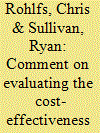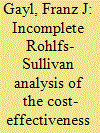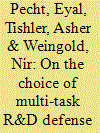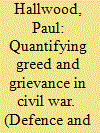| Srl | Item |
| 1 |
ID:
123169


|
|
|
|
|
| Publication |
2013.
|
| Summary/Abstract |
This comment discusses the pros and cons of the methodology and data used in our previous study on the cost-effectiveness of armor on Tactical Wheeled Vehicles (TWVs), and responds to recent critiques by Franz Gayl. In our previous article, we evaluated the large-scale Army policies to replace relatively light Type 1 Tactical Wheeled Vehicles (TWVs) with moderately protected Type 2 variants, and later to replace Type 2s with heavily protected Type 3s. We find that the switch from Type 2 to Type 3 TWVs did not appreciably reduce fatalities and were not cost-effective. Mr. Gayl contends that the data and choice of control variables used in our original study negatively bias our findings for Type 3 TWVs. We defend our previous conclusions and argue that Gayl's suggested approach of focusing on deaths per insurgent attack fails to account for effects of the vehicles on when, where, and how attacks occurred. Our methodology does not suffer from this bias and measures effects on total unit casualties rather those incurred per attack. We explain that our estimates are stable across many specifications and are not sensitive to the choice of controls as Gayl suggests.
|
|
|
|
|
|
|
|
|
|
|
|
|
|
|
|
| 2 |
ID:
123165


|
|
|
|
|
| Publication |
2013.
|
| Summary/Abstract |
This paper examines the impact of military spending on general government debt in the enlarged European Union (EU) countries. For this purpose, we use panel data analysis and provide estimates from a dynamic Generalized Method of Moments (GMM) panel model. The dynamics are found to be important and the results suggest that military expenditures do have a large positive impact on the share of general government debt in the EU.
|
|
|
|
|
|
|
|
|
|
|
|
|
|
|
|
| 3 |
ID:
123168


|
|
|
|
|
| Publication |
2013.
|
| Summary/Abstract |
This comment addresses the Rohlfs-Sullivan analysis titled: 'The Cost-Effectiveness of Armored Tactical Wheeled Vehicles [TWVs] for Overseas US Army Operations.' The analysis evaluated policies to replace Type 1 and 2 TWVs with Type 3s. There is no evidence the analysis factored in fatality causes, fatality relationships to vehicles, or compared survivability of vehicles. Furthermore, it did not note when Type 3 TWVs were requested, when they impacted fatalities, or TWV use policies. It also assumed Type 3 TWVs prompted negative unit behaviors while discounting evidence of positive behaviors. In summary, the analysis is incomplete and should be revised.
|
|
|
|
|
|
|
|
|
|
|
|
|
|
|
|
| 4 |
ID:
123166


|
|
|
|
|
| Publication |
2013.
|
| Summary/Abstract |
Investments in R&D constitute a major share of the expenditures of the hi-tech industry since, generally, they enable firms to successfully compete in the rapidly and constantly changing markets for hi-tech products and services. The role of R&D projects is particularly important in the areas of defense and homeland security due to the nature of warfare and the continuous threats posed by arms races and by terror organizations. This study analyzes the choice of the R&D projects designed to counter multiple related military threats. It develops the methodology required to assess whether it is preferable to develop one project to thwart several related threats, or several distinct projects, each of which provides an answer to one specific threat or a partial set of the threats. An analytic solution is provided and assessed for two simple models with two related threats. A solution of the model is then provided for any number of related threats, using a dynamic programming methodology. Finally, we demonstrate the usefulness of our model and methodology to Israel's missile defense problem; that is, we show how to optimally develop systems aimed at thwarting the multiple threats of short-, medium-, and long-range missiles.
|
|
|
|
|
|
|
|
|
|
|
|
|
|
|
|
| 5 |
ID:
123164


|
|
|
|
|
| Publication |
2013.
|
| Summary/Abstract |
A growing body of literature has recently focused on the economic origins and consequences of modern maritime piracy and on the perception that the international community has failed to control it. This paper aims to investigate maritime transport costs as one of the channels through which modern maritime piracy could have a major impact on the global economy. A transport-cost equation is estimated using a newly released data-set on maritime transport costs from the Organization for Economic Cooperation and Development together with data on maritime piracy from the International Maritime Bureau. Our results show that maritime piracy significantly increases trade costs between Europe and Asia.
|
|
|
|
|
|
|
|
|
|
|
|
|
|
|
|
| 6 |
ID:
123167


|
|
|
|
|
| Publication |
2013.
|
| Summary/Abstract |
Greed' vs. 'grievance' is weighed using a generally applicable methodology as motivations in the American War of Independence. Greed is quantified as the expected economic benefit of Independence - escaping colonial trade burdens and expected increased economic growth rates. Grievance is measured as willingness to pay to escape perceived political burdens. Quantification of the relative contributions is made possible by using estimates of expected war-costs. To the extent that the economic burden was insufficient to explain the War, the residual is ascribed to the grievance motivation. Both motives are shown to have contributed to the War, but grievance dominates.
|
|
|
|
|
|
|
|
|
|
|
|
|
|
|
|